Deck 10: From Proteins to Phenotypes
Question
Question
Question
Question
Question
Question
Question
Question
Question
Question
Question
Question
Question
Question
Question
Question
Question
Question
Question
Question
Question
Question
Question
Question
Question
Question

Unlock Deck
Sign up to unlock the cards in this deck!
Unlock Deck
Unlock Deck
1/26
Play
Full screen (f)
Deck 10: From Proteins to Phenotypes
1
A couple was referred for genetic counseling because they wanted to know the chances of having a child with dwarfism. Both the man and the woman had achondroplasia (MIM 100800), the most common form of short-limbed dwarfism. The couple knew that this condition is inherited as an autosomal dominant trait, but they were unsure what kind of physical manifestations a child would have if it inherited both mutant alleles. They were each heterozygous for the FGFR3 (MIM 134934) allele that causes achondroplasia. Normally, the protein encoded by this gene interacts with growth factors outside the cell and receives signals that control growth and development. In achrodroplasia, a mutation alters the activity of the receptor, resulting in a characteristic form of dwarfism. Because both the normal and mutant forms of the FGFR3 protein act before birth, no treatment for achrondroplasia is available.
The parents each carry one normal allele and one mutant allele of FGRF3 , and they wanted information on their chances of having a homozygous child. The counselor briefly reviewed the phenotypic features of individuals with achondroplasia. These include facial features (large head with prominent forehead; small, flat nasal bridge; and prominent jaw), very short stature, and shortening of the arms and legs. Physical examination and skeletal X-ray films are used to diagnose this condition. Final adult height is approximately 4 feet.
Because achondroplasia is an autosomal dominant condition, a heterozygote has a 1-in-2, or 50%, chance of passing this trait to his or her offspring. However, about 75% of those with achondroplasia have parents of average size who do not carry the mutant allele. In these cases, achondroplasia is due to a new mutation. In the couple being counseled, each individual is heterozygous, and they are at risk for having a homozygous child with two copies of the mutated gene. Infants with homozygous achondroplasia are either stillborn or die shortly after birth. The counselor recommended prenatal diagnosis via ultrasounds at various stages of development. In addition, a DNA test is available to detect the homozygous condition prenatally.
What is the chance that this couple will have a child with two copies of the dominant mutant gene What is the chance that the child will have normal height
The parents each carry one normal allele and one mutant allele of FGRF3 , and they wanted information on their chances of having a homozygous child. The counselor briefly reviewed the phenotypic features of individuals with achondroplasia. These include facial features (large head with prominent forehead; small, flat nasal bridge; and prominent jaw), very short stature, and shortening of the arms and legs. Physical examination and skeletal X-ray films are used to diagnose this condition. Final adult height is approximately 4 feet.
Because achondroplasia is an autosomal dominant condition, a heterozygote has a 1-in-2, or 50%, chance of passing this trait to his or her offspring. However, about 75% of those with achondroplasia have parents of average size who do not carry the mutant allele. In these cases, achondroplasia is due to a new mutation. In the couple being counseled, each individual is heterozygous, and they are at risk for having a homozygous child with two copies of the mutated gene. Infants with homozygous achondroplasia are either stillborn or die shortly after birth. The counselor recommended prenatal diagnosis via ultrasounds at various stages of development. In addition, a DNA test is available to detect the homozygous condition prenatally.
What is the chance that this couple will have a child with two copies of the dominant mutant gene What is the chance that the child will have normal height
The parents are both heterozygous for achondroplasia gene. Let the variables represent the following:
• A for achondroplasia gene and a for normal gene.
• Both parents have genotype Aa heterozygous.
In order to find the genotypes of the children, test cross is done on Punnet square. The genotypes of their children are as follows:
The genotypes of their children are as follows:
• AA homozygous achondroplasia 1 in 4 or 25%. This is said to be a deadly condition.
• Aa heterozygous achondroplasia 2 in 4 or 50%.
• aa normal 1 in 4 or 25%.
• A for achondroplasia gene and a for normal gene.
• Both parents have genotype Aa heterozygous.
In order to find the genotypes of the children, test cross is done on Punnet square.
 The genotypes of their children are as follows:
The genotypes of their children are as follows:• AA homozygous achondroplasia 1 in 4 or 25%. This is said to be a deadly condition.
• Aa heterozygous achondroplasia 2 in 4 or 50%.
• aa normal 1 in 4 or 25%.
2
Many individuals with metabolic diseases are normal at birth but show symptoms shortly thereafter. Why
Metabolic diseases normal at birth; thereafter, showing symptoms are:
Explanation
Metabolic diseases refer to people who lack enzymes that enhance proteins to digest food and breakdown of chemicals. Moreover, absence of crucial enzymes may lead to build undesirable and toxic chemicals in the body. Before birth, the fetus gets all its nutrition from the mother, so it doesn't necessarily require the use of his/her own enzymes. Since, mother's enzymes may breakdown chemicals that are required for fetus. However, after birth baby will have to rely on his/her enzymes and if there is a deficiency they will not be able to breakdown the chemicals in their body.
Explanation
Metabolic diseases refer to people who lack enzymes that enhance proteins to digest food and breakdown of chemicals. Moreover, absence of crucial enzymes may lead to build undesirable and toxic chemicals in the body. Before birth, the fetus gets all its nutrition from the mother, so it doesn't necessarily require the use of his/her own enzymes. Since, mother's enzymes may breakdown chemicals that are required for fetus. However, after birth baby will have to rely on his/her enzymes and if there is a deficiency they will not be able to breakdown the chemicals in their body.
3
A couple was referred for genetic counseling because they wanted to know the chances of having a child with dwarfism. Both the man and the woman had achondroplasia (MIM 100800), the most common form of short-limbed dwarfism. The couple knew that this condition is inherited as an autosomal dominant trait, but they were unsure what kind of physical manifestations a child would have if it inherited both mutant alleles. They were each heterozygous for the FGFR3 (MIM 134934) allele that causes achondroplasia. Normally, the protein encoded by this gene interacts with growth factors outside the cell and receives signals that control growth and development. In achrodroplasia, a mutation alters the activity of the receptor, resulting in a characteristic form of dwarfism. Because both the normal and mutant forms of the FGFR3 protein act before birth, no treatment for achrondroplasia is available.
The parents each carry one normal allele and one mutant allele of FGRF3 , and they wanted information on their chances of having a homozygous child. The counselor briefly reviewed the phenotypic features of individuals with achondroplasia. These include facial features (large head with prominent forehead; small, flat nasal bridge; and prominent jaw), very short stature, and shortening of the arms and legs. Physical examination and skeletal X-ray films are used to diagnose this condition. Final adult height is approximately 4 feet.
Because achondroplasia is an autosomal dominant condition, a heterozygote has a 1-in-2, or 50%, chance of passing this trait to his or her offspring. However, about 75% of those with achondroplasia have parents of average size who do not carry the mutant allele. In these cases, achondroplasia is due to a new mutation. In the couple being counseled, each individual is heterozygous, and they are at risk for having a homozygous child with two copies of the mutated gene. Infants with homozygous achondroplasia are either stillborn or die shortly after birth. The counselor recommended prenatal diagnosis via ultrasounds at various stages of development. In addition, a DNA test is available to detect the homozygous condition prenatally.
Should the parents be concerned about the heterozygous condition as well as the homozygous mutant condition
The parents each carry one normal allele and one mutant allele of FGRF3 , and they wanted information on their chances of having a homozygous child. The counselor briefly reviewed the phenotypic features of individuals with achondroplasia. These include facial features (large head with prominent forehead; small, flat nasal bridge; and prominent jaw), very short stature, and shortening of the arms and legs. Physical examination and skeletal X-ray films are used to diagnose this condition. Final adult height is approximately 4 feet.
Because achondroplasia is an autosomal dominant condition, a heterozygote has a 1-in-2, or 50%, chance of passing this trait to his or her offspring. However, about 75% of those with achondroplasia have parents of average size who do not carry the mutant allele. In these cases, achondroplasia is due to a new mutation. In the couple being counseled, each individual is heterozygous, and they are at risk for having a homozygous child with two copies of the mutated gene. Infants with homozygous achondroplasia are either stillborn or die shortly after birth. The counselor recommended prenatal diagnosis via ultrasounds at various stages of development. In addition, a DNA test is available to detect the homozygous condition prenatally.
Should the parents be concerned about the heterozygous condition as well as the homozygous mutant condition
Achondroplasia causes a type of dwarfism, which is autosomal dominant and is expressed by heterozygotes. However, dwarfism is usually not a life threatening issue and people with it can live normal lives. However, achondroplasia would be an issue if parents desire only a normal height child. Otherwise, homozygous achondroplasia is a deadly condition and the child can be stillborn. This would be a major cause of concern for healthy pregnancy.
4
List the ways in which a metabolic block can have phenotypic effects.

Unlock Deck
Unlock for access to all 26 flashcards in this deck.
Unlock Deck
k this deck
5
A couple was referred for genetic counseling because they wanted to know the chances of having a child with dwarfism. Both the man and the woman had achondroplasia (MIM 100800), the most common form of short-limbed dwarfism. The couple knew that this condition is inherited as an autosomal dominant trait, but they were unsure what kind of physical manifestations a child would have if it inherited both mutant alleles. They were each heterozygous for the FGFR3 (MIM 134934) allele that causes achondroplasia. Normally, the protein encoded by this gene interacts with growth factors outside the cell and receives signals that control growth and development. In achrodroplasia, a mutation alters the activity of the receptor, resulting in a characteristic form of dwarfism. Because both the normal and mutant forms of the FGFR3 protein act before birth, no treatment for achrondroplasia is available.
The parents each carry one normal allele and one mutant allele of FGRF3 , and they wanted information on their chances of having a homozygous child. The counselor briefly reviewed the phenotypic features of individuals with achondroplasia. These include facial features (large head with prominent forehead; small, flat nasal bridge; and prominent jaw), very short stature, and shortening of the arms and legs. Physical examination and skeletal X-ray films are used to diagnose this condition. Final adult height is approximately 4 feet.
Because achondroplasia is an autosomal dominant condition, a heterozygote has a 1-in-2, or 50%, chance of passing this trait to his or her offspring. However, about 75% of those with achondroplasia have parents of average size who do not carry the mutant allele. In these cases, achondroplasia is due to a new mutation. In the couple being counseled, each individual is heterozygous, and they are at risk for having a homozygous child with two copies of the mutated gene. Infants with homozygous achondroplasia are either stillborn or die shortly after birth. The counselor recommended prenatal diagnosis via ultrasounds at various stages of development. In addition, a DNA test is available to detect the homozygous condition prenatally.
What if the couple wanted prenatal testing so that a normal fetus could be aborted
The parents each carry one normal allele and one mutant allele of FGRF3 , and they wanted information on their chances of having a homozygous child. The counselor briefly reviewed the phenotypic features of individuals with achondroplasia. These include facial features (large head with prominent forehead; small, flat nasal bridge; and prominent jaw), very short stature, and shortening of the arms and legs. Physical examination and skeletal X-ray films are used to diagnose this condition. Final adult height is approximately 4 feet.
Because achondroplasia is an autosomal dominant condition, a heterozygote has a 1-in-2, or 50%, chance of passing this trait to his or her offspring. However, about 75% of those with achondroplasia have parents of average size who do not carry the mutant allele. In these cases, achondroplasia is due to a new mutation. In the couple being counseled, each individual is heterozygous, and they are at risk for having a homozygous child with two copies of the mutated gene. Infants with homozygous achondroplasia are either stillborn or die shortly after birth. The counselor recommended prenatal diagnosis via ultrasounds at various stages of development. In addition, a DNA test is available to detect the homozygous condition prenatally.
What if the couple wanted prenatal testing so that a normal fetus could be aborted

Unlock Deck
Unlock for access to all 26 flashcards in this deck.
Unlock Deck
k this deck
6
Enzymes have all the following characteristics except:
A) they act as biological catalysts
B) they are proteins
C) they carry out random chemical reactions
D) they convert substrates into products
E) they can cause genetic disease
A) they act as biological catalysts
B) they are proteins
C) they carry out random chemical reactions
D) they convert substrates into products
E) they can cause genetic disease

Unlock Deck
Unlock for access to all 26 flashcards in this deck.
Unlock Deck
k this deck
7
The following hypothetical pathway in which substance A is converted to substance C by enzymes 1 and 2. Substance B is the intermediate produced in this pathway: 
a. If an individual is homozygous for a null mutation in the gene that codes for enzyme 1, what will the result be
b. If an individual is homozygous for a null mutation in enzyme 2, what will the result be
c. What if an individual is heterozygous for a dominant mutation in which enzyme 1 is overactive
d. What if an individual is heterozygous for a mutation that abolishes the activity of enzyme 2 (a null mutation)

a. If an individual is homozygous for a null mutation in the gene that codes for enzyme 1, what will the result be
b. If an individual is homozygous for a null mutation in enzyme 2, what will the result be
c. What if an individual is heterozygous for a dominant mutation in which enzyme 1 is overactive
d. What if an individual is heterozygous for a mutation that abolishes the activity of enzyme 2 (a null mutation)

Unlock Deck
Unlock for access to all 26 flashcards in this deck.
Unlock Deck
k this deck
8
The following hypothetical pathway in which substance A is converted to substance C by enzymes 1 and 2. Substance B is the intermediate produced in this pathway: 
A) If the first individual in Question 4 married the second individual, would their children be able to convert substance A into substance C
B) Suppose each of the adults mentioned in part a was heterozygous for an autosomal dominant mutation that prevents any enzyme function. List the phenotypes of their children with respect to compounds A, B, and C. (Would the compound be in excess, not present, and so on )

A) If the first individual in Question 4 married the second individual, would their children be able to convert substance A into substance C
B) Suppose each of the adults mentioned in part a was heterozygous for an autosomal dominant mutation that prevents any enzyme function. List the phenotypes of their children with respect to compounds A, B, and C. (Would the compound be in excess, not present, and so on )

Unlock Deck
Unlock for access to all 26 flashcards in this deck.
Unlock Deck
k this deck
9
The following hypothetical pathway in which substance A is converted to substance C by enzymes 1 and 2. Substance B is the intermediate produced in this pathway: 
An individual is heterozygous for a recessive mutation in enzyme 1 and heterozygous for a recessive mutation in enzyme 2. This individual marries an individual with the same genotype. List the possible genotypes of their children. For every genotype, determine the activity of enzymes 1 and 2, assuming that the mutant alleles have 0% activity and that each normal allele has 50% activity. For every genotype, determine if compound C will be made. If compound C is not made, list the compound that will be in excess.

An individual is heterozygous for a recessive mutation in enzyme 1 and heterozygous for a recessive mutation in enzyme 2. This individual marries an individual with the same genotype. List the possible genotypes of their children. For every genotype, determine the activity of enzymes 1 and 2, assuming that the mutant alleles have 0% activity and that each normal allele has 50% activity. For every genotype, determine if compound C will be made. If compound C is not made, list the compound that will be in excess.

Unlock Deck
Unlock for access to all 26 flashcards in this deck.
Unlock Deck
k this deck
10
Hypothetical metabolic disease in which protein E is not produced. Lack of protein E causes intellectual disability in humans. Protein E's function is not known, but it is found in all cells of the body. Skin cells from eight individuals who cannot produce protein E were taken and grown in culture. The defect in each of the individuals is the result of a single recessive mutation. Each individual is homozygous for her or his mutation. The cells from one individual were grown with the cells from another individual in all possible combinations of the two. After a few weeks of growth, the mixed cultures were assayed for the presence of protein E. The results are given in the following table. A plus sign means that the two cell types produced protein E when grown together (but not separately); a minus sign means that the two cell types still could not produce protein E. 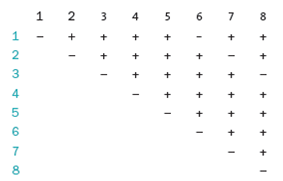
a. Which individuals seem to have the same defect in protein-E production
b. If individual 2 married individual 3, would their children be able to make protein E
c. If individual 1 married individual 6, would their children be able to make protein E

a. Which individuals seem to have the same defect in protein-E production
b. If individual 2 married individual 3, would their children be able to make protein E
c. If individual 1 married individual 6, would their children be able to make protein E

Unlock Deck
Unlock for access to all 26 flashcards in this deck.
Unlock Deck
k this deck
11
Hypothetical metabolic disease in which protein E is not produced. Lack of protein E causes intellectual disability in humans. Protein E's function is not known, but it is found in all cells of the body. Skin cells from eight individuals who cannot produce protein E were taken and grown in culture. The defect in each of the individuals is the result of a single recessive mutation. Each individual is homozygous for her or his mutation. The cells from one individual were grown with the cells from another individual in all possible combinations of the two. After a few weeks of growth, the mixed cultures were assayed for the presence of protein E. The results are given in the following table. A plus sign means that the two cell types produced protein E when grown together (but not separately); a minus sign means that the two cell types still could not produce protein E. 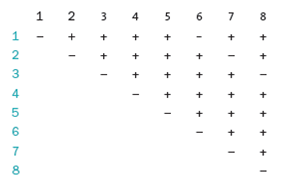
a. Assuming that these individuals represent all possible mutants in the synthesis of protein E, how many steps are there in the pathway to protein-E production
b. Compounds A, B, C, and D are known to be intermediates in the pathway for production of protein E. To determine where the block in protein-E production occurred in each individual, the various intermediates were given to each individual's cells in culture. After a few weeks of growth with the intermediate, the cells were assayed for the production of protein E. The results for each individual's cells are given in the following table. A plus sign means that protein E was produced after the cells were given the intermediate listed at the top of the column. A minus sign means that the cells still could not produce protein E even after being exposed to the intermediate at the top of the column.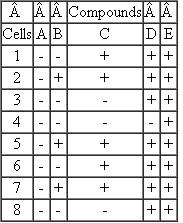

a. Assuming that these individuals represent all possible mutants in the synthesis of protein E, how many steps are there in the pathway to protein-E production
b. Compounds A, B, C, and D are known to be intermediates in the pathway for production of protein E. To determine where the block in protein-E production occurred in each individual, the various intermediates were given to each individual's cells in culture. After a few weeks of growth with the intermediate, the cells were assayed for the production of protein E. The results for each individual's cells are given in the following table. A plus sign means that protein E was produced after the cells were given the intermediate listed at the top of the column. A minus sign means that the cells still could not produce protein E even after being exposed to the intermediate at the top of the column.


Unlock Deck
Unlock for access to all 26 flashcards in this deck.
Unlock Deck
k this deck
12
Hypothetical metabolic disease in which protein E is not produced. Lack of protein E causes intellectual disability in humans. Protein E's function is not known, but it is found in all cells of the body. Skin cells from eight individuals who cannot produce protein E were taken and grown in culture. The defect in each of the individuals is the result of a single recessive mutation. Each individual is homozygous for her or his mutation. The cells from one individual were grown with the cells from another individual in all possible combinations of the two. After a few weeks of growth, the mixed cultures were assayed for the presence of protein E. The results are given in the following table. A plus sign means that the two cell types produced protein E when grown together (but not separately); a minus sign means that the two cell types still could not produce protein E. 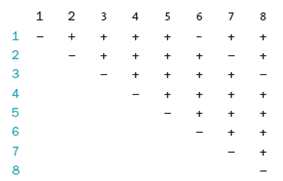
Draw the pathway leading to the production of protein E.

Draw the pathway leading to the production of protein E.

Unlock Deck
Unlock for access to all 26 flashcards in this deck.
Unlock Deck
k this deck
13
Hypothetical metabolic disease in which protein E is not produced. Lack of protein E causes intellectual disability in humans. Protein E's function is not known, but it is found in all cells of the body. Skin cells from eight individuals who cannot produce protein E were taken and grown in culture. The defect in each of the individuals is the result of a single recessive mutation. Each individual is homozygous for her or his mutation. The cells from one individual were grown with the cells from another individual in all possible combinations of the two. After a few weeks of growth, the mixed cultures were assayed for the presence of protein E. The results are given in the following table. A plus sign means that the two cell types produced protein E when grown together (but not separately); a minus sign means that the two cell types still could not produce protein E. 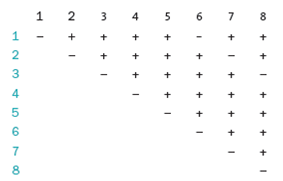
Denote the point in the pathway in which each individual is blocked.

Denote the point in the pathway in which each individual is blocked.

Unlock Deck
Unlock for access to all 26 flashcards in this deck.
Unlock Deck
k this deck
14
Hypothetical metabolic disease in which protein E is not produced. Lack of protein E causes intellectual disability in humans. Protein E's function is not known, but it is found in all cells of the body. Skin cells from eight individuals who cannot produce protein E were taken and grown in culture. The defect in each of the individuals is the result of a single recessive mutation. Each individual is homozygous for her or his mutation. The cells from one individual were grown with the cells from another individual in all possible combinations of the two. After a few weeks of growth, the mixed cultures were assayed for the presence of protein E. The results are given in the following table. A plus sign means that the two cell types produced protein E when grown together (but not separately); a minus sign means that the two cell types still could not produce protein E. 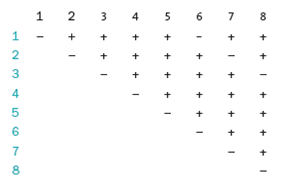
a. If an individual who is homozygous for the mutation found in individual 2 and heterozygous for the mutation found in individual 4 marries an individual who is homozygous for the mutation found in individual 4 and heterozygous for the mutation found in individual 2, what will be the phenotype of their children
b. List the intermediate that would build up in each of the types of children who could not produce protein E.

a. If an individual who is homozygous for the mutation found in individual 2 and heterozygous for the mutation found in individual 4 marries an individual who is homozygous for the mutation found in individual 4 and heterozygous for the mutation found in individual 2, what will be the phenotype of their children
b. List the intermediate that would build up in each of the types of children who could not produce protein E.

Unlock Deck
Unlock for access to all 26 flashcards in this deck.
Unlock Deck
k this deck
15
Essential amino acids are:
A) amino acids the human body can synthesize
B) amino acids humans need in their diet
C) amino acids in a box of Frosted Flakes
D) amino acids that include arginine and glutamic acid
E) amino acids that cannot harm the body if not metabolized properly
A) amino acids the human body can synthesize
B) amino acids humans need in their diet
C) amino acids in a box of Frosted Flakes
D) amino acids that include arginine and glutamic acid
E) amino acids that cannot harm the body if not metabolized properly

Unlock Deck
Unlock for access to all 26 flashcards in this deck.
Unlock Deck
k this deck
16
Suppose that in the formation of phenylalanine hydroxylase mRNA, the exons of the pre-mRNA fail to splice together properly and the resulting enzyme is nonfunctional. This produces an accumulation of high levels of phenylalanine and other compounds, which causes neurological damage. What phenotype would be produced in the affected individual

Unlock Deck
Unlock for access to all 26 flashcards in this deck.
Unlock Deck
k this deck
17
If phenylalanine was not an essential amino acid, would diet therapy (the elimination of phenylalanine from the diet) for PKU work

Unlock Deck
Unlock for access to all 26 flashcards in this deck.
Unlock Deck
k this deck
18
Phenylketonuria and alkaptonuria are both autosomal recessive diseases. If a person with PKU marries a person with AKU, what will the phenotype of their children be

Unlock Deck
Unlock for access to all 26 flashcards in this deck.
Unlock Deck
k this deck
19
The normal enzyme required for converting sugars into glucose is present in cells, but the conversion never takes place and no glucose is produced. What could have occurred to cause this defect in a metabolic pathway

Unlock Deck
Unlock for access to all 26 flashcards in this deck.
Unlock Deck
k this deck
20
Knowing that individuals who are homozygous for the G D allele show no symptoms of galactosemia, is it surprising that galactosemia is a recessive disease Why

Unlock Deck
Unlock for access to all 26 flashcards in this deck.
Unlock Deck
k this deck
21
Describe the quaternary structure of the blood protein hemoglobin.

Unlock Deck
Unlock for access to all 26 flashcards in this deck.
Unlock Deck
k this deck
22
A person was found to have very low levels of functional beta globin mRNA and therefore very low levels of the beta globin protein. What problems would this cause for assembling functional hemoglobin molecules

Unlock Deck
Unlock for access to all 26 flashcards in this deck.
Unlock Deck
k this deck
23
If an extra nucleotide is inserted in the first exon of the beta globin gene, what effect will it have on the amino acid sequence of the globin polypeptides Will the globin most likely be fully functional, partly functional, or nonfunctional Why

Unlock Deck
Unlock for access to all 26 flashcards in this deck.
Unlock Deck
k this deck
24
Transcriptional regulators are proteins that bind to promoters (the 59-flanking regions of genes) to regulate their transcription. Assume that a particular transcription regulator normally promotes transcription of gene X , a transport protein. If a mutation makes this regulator gene nonfunctional, would the resulting phenotype be similar to a mutation in gene X itself Why or why not

Unlock Deck
Unlock for access to all 26 flashcards in this deck.
Unlock Deck
k this deck
25
Explain why there are variant responses to drugs and why these responses act as heritable traits.

Unlock Deck
Unlock for access to all 26 flashcards in this deck.
Unlock Deck
k this deck
26
Ecogenetics is a branch of genetics that deals with the genetic variation that underlies reactive differences to drugs, chemicals in food, occupational exposure, industrial pollution, and other substances. Cases have arisen in which workers claim that exposure to a certain agent has made them feel ill, whereas other workers are unaffected. Although claims like these are not always justified, what are some concrete examples that prove that variation in reactions to certain substances exist in the human population

Unlock Deck
Unlock for access to all 26 flashcards in this deck.
Unlock Deck
k this deck



